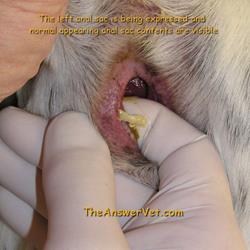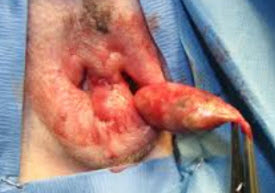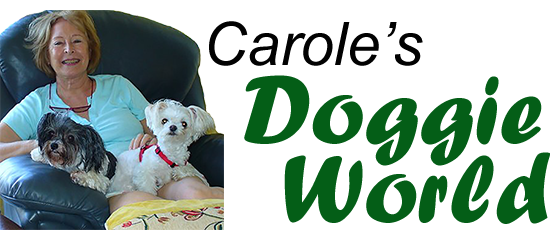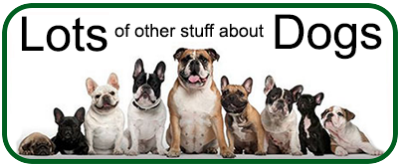Is your dog scooting its behind on your carpet or ground? It's trying to tell you something!
Anal sac disease in dogs
What are anal glands?
The anal glands (also called anal sacs) are two glands which secrete a pungent fluid that travels through tiny ducts which open into the anus. Typically, this fluid is released during defecation.
Where are the anal glands located?
.jpg)
The anal glands are located on either side of the anus, just under the skin, at the 4 o'clock and 8 o'clock positions. The glands are embedded in the muscle of the anal sphincter and are not readily visible.
What is the general structure of the anal glands?
The anal glands are small and oval shaped. The tissue within the glands produces a fluid that is collected in a multitude of tiny ducts. As feces pass through the anus, the glands are squeezed and the duct releases the fluid through small pores.
What is the function of the anal glands?
The only known function of the anal glands is to produce small amounts of anal gland secretions, ranging in color from yellow brown to gray. It is theorised that these secretions are used by dogs as a way to mark and identify their territory. The secretions from these glands are very pungent and may also be expressed when a dog is frightened or alarmed.
Signs and symptoms of anal gland disease to watch for

- Dogs scooting or dragging their anus on the ground or carpet
- Dogs frequently licking their anus or tail base
- Dogs showing a reluctance to sit or sitting asymmetrically to avoid pressure on their painful anal sacs
- Dogs straining or having difficulty to defecate and or producing ribbon-like stools
- Painful swelling at the 4 o'clock or 8 o'clock locations around the anal area
NB - Similar signs to anal sac disease can be seen in dogs with a different disease called "perianal fistul", and it is important to be aware of the difference. Perianal fistul is a severe condition of the tissue around the anus, creating fistulas, or draining/oozing tracts, around the anus. It is most commonly seen in German shepherds, and is also seen in Irish setters.
The cause of this difficult to control disease is unknown, but is currently thought to have an immune-mediated origin (which means that the dog's immune system is for some unknown reason attacking the tissues around the anus). German shepherds and Irish setters with symptoms of anal sac disease should also be screened for this more serious disease.
What are common diseases of the anal glands?
Types of anal sac disease include:
- Anal sac impaction
- Anal sacculitis
- Anal sac infection or abscess formation
- Anal sac tumours
Anal sac impaction
Impaction is more commonly seen in small breed dogs and is the result of large amounts of thick anal sac secretions that cannot be expressed by the dog during defecation. The secretions build up and cause discomfort as the sac becomes distended.
Iimpaction can lead to inflammation or infection of the anal sacs. Dogs are more commonly affected with anal sac disease than cats. Small breed dogs are more commonly affected with anal sac impaction than large breed dogs. Older female dogs are more commonly affected with anal sac tumors.
What to do? Take your furry friend to the vet.
Anal sacculitis
This is inflammation of the anal sac, which can be caused by impacted anal sac secretions or bacterial infections of the anal sacs. Anal sacculitis is more painful than anal sac impaction. In addition to scooting and excessive licking, you may notice your pet straining to defecate, being reluctant to sit, or sitting asymmetrically.
What to do? Take your furry friend to the vet.
Anal sac infection or abscess formation
This is a pus-filled anal sac that results from a bacterial infection. Anal sac abscesses are more painful than anal sac impaction. In addition to scooting, excessive licking, and straining to defecate, you may also notice a red swelling near the anus, or pus dripping from an open wound near the anus if the abscess has already ruptured.
What to do? Take your furry friend to the vet.
Anal sac tumours
Anal sac tumors (apocrine gland adenocarcinomas) are not often painful and do not usually have redness on the overlying skin or any open wounds. They occur mostly in older female dogs, spayed as well as unspayed. They can cause an increase in blood calcium levels, which can cause clinical signs such as increased drinking and urination.
They most often spread to the sublumbar lymph nodes, which are located in the abdomen right below the lumbar vertebrae. If the lymph nodes become enlarged due to spread of the cancer, they can obstruct flow of feces by putting pressure on the colon. This may show itself as difficulty defecating or producing ribbon-like stools. Dogs with anal sac tumors can also have symptoms associated with other types of anal sac disease, including scooting, excessive licking, straining to defecate, reluctance to sit, or sitting asymmetrically.
What to do? Take your furry friend to the vet.
Diagnosis in depth - Ask your Vet
History
Your vet will ask specific questions regarding defecation habits (straining, size/shape of stool, frequency, pain), appetite, weight loss, drinking and urination habits, what symptoms you have noticed and how long they have been going on.
Physical exam
Your vet will perform a complete physical exam, including a rectal exam of the anal sacs. The veterinarian will attempt to express the anal sacs and note the quality of the secretions.
Blood tests

If your vet suspects an infection or abscess of the anal sacs, he or she may recommend a complete blood count, which will assess the number and type of red and white blood cells and platelets. The white blood cell count will usually increase in an infection.
If your veterinarian suspects an anal sac tumor, he or she will recommend a serum chemistry panel, important if the dog will need anesthesia. This test checks the major organs to see if they are functioning normally and also checks the levels of the major electrolytes in the body. Anal sac tumors can cause an increase in serum calcium levels in the blood.
Chest and abdominal X-rays
Anal sac tumors can spread to lymph nodes and lungs, and rarely to other organs or bones of the body. X-rays are used to check for obvious spread of the cancer, although microscopic spread cannot be ruled out. Chest x-rays are also important in older dogs that will be undergoing anesthesia, to make sure that there is no heart or lung disease that would make anesthesia risky.
Abdominal ultrasound
The most common location for anal sac tumors to spread is the sublumbar lymph nodes. These lymph nodes can become extremely large, and may be able to be palpated rectally. If not, they can be seen using an ultrasound. If the lymph nodes become very large, they can push on the colon and obstruct flow of feces. This can make defecation difficult and may alter the shape or size of the stool.
Treatment In-depth
Anal sac expression

The veterinarian rectally palpates the anal sacs and squeezes them to empty the sacs of the secretions. If the dog is too painful or if the secretions are too firm, then the patient may need to be heavily sedated or anesthetized to have this procedure done. Anal sac expression is often all that needs to be done for simple cases of anal sac impaction or mild cases of anal sacculitis.
Anal sac irrigation
This involves anesthetizing the patient and flushing saline into the opening of the anal sac to break up firm anal sac secretions so that the sacs can be emptied. This procedure is indicated when the anal sacs cannot be manually expressed. More severe cases of anal sacculitis often require subsequent irrigation with a topical steroid to help decrease the inflammation.
Abscess lancing
An anal sac abscess, unless it has already ruptured on its own, needs to be opened up, or lanced and drained. The dog may be briefly anesthetized, and the abscess is opened up and flushed with saline. Antibiotics are indicated to treat the underlying infection. Warm compresses applied to the area are also helpful.
Anal Gland Removal
Anal gland removal is indicated in cases of chronic, recurrent anal sac infections and anal gland tumors.
Anal sacculectomy

This is the technical term for surgical removal of the anal sac. It is often recommended for recurrent cases of anal sac infection or anal sac impaction, and is necessary for treatment of anal sac tumours. This can be done to one or both sides as needed. The animal is placed under general anesthesia and an incision is made over the anal gland. The gland is dissected away from the anal sphincter muscle and removed. It is submitted for biopsy.
The possible risks of surgery, besides the risks of general anesthesia, are fecal incontinence, chronic draining tracts from residual infection or secretory tissue, recurrence of the tumor, and straining to defecate from postoperative anal scar formation.
Sublumbar lymph node removal
If a tumour of the anal sac has spread to the sublumbar lymph nodes, then removal of the lymph nodes can be considered.
This is a technically challenging procedure that can result in significant bleeding during surgery and could also result in temporary or permanent urinary incontinence since the nerves controlling urination are close to the lymph nodes. It is not curative, although it may alleviate some of the problems associated with the enlarged lymph nodes, such as difficulty defecating.
Optimal treatment for your pet requires a combination of home and professional veterinary care. Follow-up can be critical, especially if your pet does not rapidly improve.
- Administer all prescribed medications as directed. Alert your vet if you are experiencing problems treating your pet
- Closely follow your vet's instructions for post-operative care, including exercise restriction for one to two weeks. This allows the incision to heal
- Use an Elizabethan collar on your pet to prevent licking at the surgery site
Home Care
Be aware of your pet's normal defecation habits and stool appearance so that you can notice any changes. Contact your veterinarian if you notice any of the above signs of anal sac disease. Follow your vet's instructions for home care after anal gland removal. Give medications as instructed and use an Elizabethan collar on your pet to stop it licking at the surgery site.
Reference, with courtesy of Pet Place
Image: The Answer Vet
Image: Vet Surgery Central
Image: Sony as Impkins
This article and information forms part of the Carole's Doggie World Holistic Library and is presented for informational purposes only.The information is not intended to be a substitute for visits to your local vet. Instead, the content offers the reader information researched and written by Carole Curtis for www.carolesdoggieworld.com







